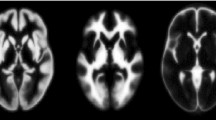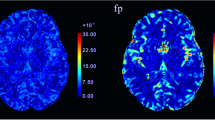Abstract
Objectives
Voxel-based morphometry (VBM) is widely used to quantify the progression of Alzheimer’s disease (AD), but improvement is still needed for accurate early diagnosis. We evaluated the feasibility of a novel diagnosis index for early diagnosis of AD based on quantitative susceptibility mapping (QSM) and VBM.
Methods
Thirty-seven patients with AD, 24 patients with mild cognitive impairment (MCI) due to AD, and 36 cognitively normal (NC) subjects from four centers were included. A hybrid sequence was performed by using 3-T MRI with a 3D multi-echo GRE sequence to obtain both a T1-weighted image for VBM and phase images for QSM. The index was calculated from specific voxels in QSM and VBM images by using a linear support vector machine. The method of voxel extraction was optimized to maximize diagnostic accuracy, and the optimized index was compared with the conventional VBM-based index using receiver operating characteristic analysis.
Results
The index was optimal when voxels were extracted as increased susceptibility (AD > NC) in the parietal lobe and decreased gray matter volume (AD < NC) in the limbic system. The optimized proposed index showed excellent performance for discrimination between AD and NC (AUC = 0.94, p = 1.1 × 10−10) and good performance for MCI and NC (AUC = 0.87, p = 1.8 × 10−6), but poor performance for AD and MCI (AUC = 0.68, p = 0.018). Compared with the conventional index, AUCs were improved for all cases, especially for MCI and NC (p < 0.05).
Conclusions
In this preliminary study, the proposed index based on QSM and VBM improved the diagnostic performance between MCI and NC groups compared with the VBM-based index.
Key Points
• We developed a novel diagnostic index for Alzheimer’s disease based on quantitative susceptibility mapping (QSM) and voxel-based morphometry (VBM).
• QSM and VBM images can be acquired simultaneously in a single sequence with little increasing scan time.
• In this preliminary study, the proposed diagnostic index improved the discriminative performance between mild cognitive impairment and normal control groups compared with the conventional VBM-based index.





Similar content being viewed by others
Abbreviations
- AAL:
-
Automated anatomical labeling
- ASL:
-
Arterial spin labeling
- AD:
-
Alzheimer’s disease
- DSM-5:
-
Diagnostic and Statistical Manual of Mental Disorders, Fifth Edition
- GM:
-
Gray matter
- MCI:
-
Mild cognitive impairment
- MMSE:
-
Mini-mental state examination
- MNI:
-
Montreal Neurological Institute
- NC:
-
Cognitively normal
- QSM:
-
Quantitative susceptibility mapping
- VBM:
-
Voxel-based morphometry
- VOI:
-
Volume of interest
References
Alzheimer’s Association (2016) 2016 Alzheimer’s disease facts and figures. Alzheimers Dement 12:459–509
Ashburner J, Friston KJ (2000) Voxel-based morphometry: the methods. Neuroimage 11:805–821
Matsuda H, Mizumura S, Nemoto K et al (2012) Automatic voxel-based morphometry of structural MRI by SPM8 plus diffeomorphic anatomic registration through exponentiated lie algebra improves the diagnosis of probable Alzheimer disease. AJNR Am J Neuroradiol 33:1109–1114
Binnewijzend MA, Kuijer JP, Benedictus MR et al (2013) Cerebral blood flow measured with 3D pseudocontinuous arterial spin-labeling MR imaging in Alzheimer disease and mild cognitive impairment: a marker for disease severity. Radiology 267:221–230
Collij LE, Heeman F, Kuijer JP et al (2016) Application of machine learning to arterial spin labeling in mild cognitive impairment and Alzheimer disease. Radiology 281:865–875
Wang K, Liang M, Wang L et al (2007) Altered functional connectivity in early Alzheimer’s disease: a resting-state fMRI study. Hum Brain Mapp 28:967–978
Agosta F, Pievani M, Geroldi C, Copetti M, Frisoni GB, Filippi M (2012) Resting state fMRI in Alzheimer’s disease: beyond the default mode network. Neurobiol Aging 33:1564–1578
Zhang Y, Schuff N, Jahng GH et al (2007) Diffusion tensor imaging of cingulum fibers in mild cognitive impairment and Alzheimer disease. Neurology 68:13–19
Graña M, Termenon M, Savio A et al (2011) Computer aided diagnosis system for Alzheimer disease using brain diffusion tensor imaging features selected by Pearson’s correlation. Neurosci Lett 502:225–229
Bron EE, Smits M, Papma JM et al (2017) Multiparametric computer-aided differential diagnosis of Alzheimer’s disease and frontotemporal dementia using structural and advanced MRI. Eur Radiol 27:3372–3382
Acosta-Cabronero J, Williams GB, Cardenas-Blanco A, Arnold RJ, Lupson V, Nestor PJ (2013) In vivo quantitative susceptibility mapping (QSM) in Alzheimer’s disease. PLoS One 8:e81093. https://doi.org/10.1371/journal.pone.0081093
Moon Y, Han SH, Moon WJ (2016) Patterns of brain iron accumulation in vascular dementia and Alzheimer’s dementia using quantitative susceptibility mapping imaging. J Alzheimers Dis 51:737–745
van Bergen JM, Li X, Hua J et al (2016) Colocalization of cerebral iron with amyloid beta in mild cognitive impairment. Sci Rep 6:35514. https://doi.org/10.1038/srep35514
Ayton S, Fazlollahi A, Bourgeat P et al (2017) Cerebral quantitative susceptibility mapping predicts amyloid-β-related cognitive decline. Brain 140:2112–2119
Kim HG, Park S, Rhee HY et al (2017) Quantitative susceptibility mapping to evaluate the early stage of Alzheimer’s disease. Neuroimage Clin 16:429–438
Shmueli K, de Zwart JA, van Gelderen P, Li TQ, Dodd SJ, Duyn JH (2009) Magnetic susceptibility mapping of brain tissue in vivo using MRI phase data. Magn Reson Med 62:1510–1522
Liu T, Spincemaille P, de Rochefort L, Kressler B, Wang Y (2009) Calculation of susceptibility through multiple orientation sampling (COSMOS): a method for conditioning the inverse problem from measured magnetic field map to susceptibility source image in MRI. Magn Reson Med 61:196–204
Liu T, Liu J, de Rochefort L et al (2011) Morphology enabled dipole inversion (MEDI) from a single-angle acquisition: comparison with COSMOS in human brain imaging. Magn Reson Med 66:777–783
Sato R, Shirai T, Taniguchi Y, Murase T, Bito Y, Ochi H (2017) Quantitative susceptibility mapping using the multiple dipole-inversion combination with k-space segmentation method. Magn Reson Med Sci 16:340–350
Langkammer C, Schweser F, Krebs N et al (2012) Quantitative susceptibility mapping (QSM) as a means to measure brain iron? A post mortem validation study. Neuroimage 62:1593–1599
Sun H, Walsh AJ, Lebel RM et al (2015) Validation of quantitative susceptibility mapping with Perls’ iron staining for subcortical gray matter. Neuroimage 105:486–492
Wang Y, Spincemaille P, Liu Z et al (2017) Clinical quantitative susceptibility mapping (QSM): biometal imaging and its emerging roles in patient care. J Magn Reson Imaging 46:951–971
Deistung A, Schweser F, Reichenbach JR (2017) Overview of quantitative susceptibility mapping. NMR Biomed 30:e3569. https://doi.org/10.1002/nbm.3569
Sato R, Kudo K, Kawata Y et al (2018) Hybrid sequence and analysis of T1-weighted imaging and quantitative susceptibility mapping for early diagnosis of Alzheimer’s diseases. In: Proceedings of AAIC 2018, Chicago.
Kan H, Uchida Y, Arai N et al (2020) Simultaneous voxel-based magnetic susceptibility and morphometry analysis using magnetization-prepared spoiled turbo multiple gradient echo. NMR Biomed 33:e4272. https://doi.org/10.1002/nbm.4272
Sun H, Wilman AH (2014) Background field removal using spherical mean value filtering and Tikhonov regularization. Magn Reson Med 71:1151–1157
Shirai T, Sato R, Murase T, Bito Y, Ochi H (2018) Whole brain background field removal using spherical mean value filtering and local polynomial approximation for quantitative susceptibility mapping. In: Proceedings of Joint Annual Meeting ISMRM-ESMRMB 2018, Paris
Shirai T, Sato R, Taniguchi Y, Murase T, Bito Y, Ochi H (2015) Quantitative susceptibility mapping using adaptive edge-preserving filtering. In: Proceedings of the 23rd Annual Meeting of ISMRM, Toronto, Ontario, Canada.
Ashburner J (2007) A fast diffeomorphic image registration algorithm. Neuroimage 38:95–113
Tzourio-Mazoyer N, Landeau B, Papathanassiou D et al (2002) Automated anatomical labeling of activations in SPM using a macroscopic anatomical parcellation of the MNI MRI single-subject brain. Neuroimage 15:273–289
Rolls ET, Joliot M, Tzourio-Mazoyer N (2015) Implementation of a new parcellation of the orbitofrontal cortex in the automated anatomical labeling atlas. Neuroimage 122:1–5
Hsu CW, Chang CC, Lin CJ (2003) A practical guide to support vector classification. Technical report, Department of Computer Science, National Taiwan University. Available via https://www.csie.ntu.edu.tw/~cjlin/papers/guide/guide.pdf
Carter JV, Pan J, Rai SN, Galandiuk S (2016) ROC-ing along: evaluation and interpretation of receiver operating characteristic curves. Surgery 159:1638–1645
Pemberton HG, Goodkin O, Prados F et al (2021) Automated quantitative MRI volumetry reports support diagnostic interpretation in dementia: a multi-rater, clinical accuracy study. Eur Radiol 31:5312–5323
van Bergen JMG, Li X, Quevenco FC et al (2018) Simultaneous quantitative susceptibility mapping and Flutemetamol-PET suggests local correlation of iron and β-amyloid as an indicator of cognitive performance at high age. Neuroimage 174:308–316
Tao Y, Wang Y, Rogers JT, Wang F (2014) Perturbed iron distribution in Alzheimer’s disease serum, cerebrospinal fluid, and selected brain regions: a systematic review and meta-analysis. J Alzheimers Dis 42:679–690
van Rooden S, Versluis MJ, Liem MK et al (2014) Cortical phase changes in Alzheimer’s disease at 7 T MRI: a novel imaging marker. Alzheimers Dement 10:e19–e26
Zhu W, Zhong W, Wang W et al (2009) Quantitative MR phase-corrected imaging to investigate increased brain iron deposition of patients with Alzheimer disease. Radiology 253:497–504
Nakada T, Matsuzawa H, Igarashi H, Fujii Y, Kwee IL (2008) In vivo visualization of senile-plaque-like pathology in Alzheimer’s disease patients by MR microscopy on a 7 T system. J Neuroimag 18:125–129
Lovell MA, Robertson JD, Teesdale WJ, Campbell JL, Markesbery WR (1998) Copper, iron and zinc in Alzheimer’s disease senile plaques. J Neurol Sci 158:47–52
Falangola MF, Lee SP, Nixon RA, Duff K, Helpern JA (2005) Histological co-localization of iron in Abeta plaques of PS/APP transgenic mice. Neurochem Res 30:201–205
Farooq A, Anwar S, Awais M, Rehman S (2017) A deep CNN based multi-class classification of Alzheimer’s disease using MRI. In: Proceedings of 2017 IEEE International Conference on Imaging Systems and Techniques (IST), Beijing. https://doi.org/10.1109/IST.2017.8261460
Hon M, Khan NM (2017) Towards Alzheimer’s disease classification through transfer learning. In: Proceedings of 2017 IEEE International Conference on Bioinformatics and Biomedicine (BIBM), Kansas City, Missouri. https://doi.org/10.1109/BIBM.2017.8217822
Acknowledgements
We would like to thank Dr. Taisuke Harada, Dr. Hiroyuki Kameda, Dr. Akane Miyazaki, Kinya Ishizaka, and Taro Fujiwara (Hokkaido University Hospital) for helpful discussions and their support for this study.
Funding
This research was supported by AMED under Grant Number JP18he1402002.
Author information
Authors and Affiliations
Corresponding author
Ethics declarations
Guarantor
The scientific guarantor of this publication is Prof. Kohsuke Kudo.
Conflict of Interest
Ryota Sato, Tomoki Amemiya, Yasuo Kawata, Yoshitaka Bito, Hisaaki Ochi, and Toru Shirai are employees of FUJIFILM Healthcare Corporation. Kohsuke Kudo, Makoto Sasaki, and Masafumi Harada receive research funding from FUJIFILM Healthcare Corporation.
Statistics and Biometry
One of the authors has significant statistical expertise.
No complex statistical methods were necessary for this paper.
Informed Consent
Written informed consent was obtained from all subjects in the prospective cohort.
Ethical Approval
Institutional Review Board approval was obtained.
Methodology
• prospective and retrospective
• cross-sectional study, observational
• multicenter study
Additional information
Publisher’s note
Springer Nature remains neutral with regard to jurisdictional claims in published maps and institutional affiliations.
Supplementary Information
ESM 1
(DOCX 207 kb)
Rights and permissions
About this article
Cite this article
Sato, R., Kudo, K., Udo, N. et al. A diagnostic index based on quantitative susceptibility mapping and voxel-based morphometry may improve early diagnosis of Alzheimer’s disease. Eur Radiol 32, 4479–4488 (2022). https://doi.org/10.1007/s00330-022-08547-3
Received:
Revised:
Accepted:
Published:
Issue Date:
DOI: https://doi.org/10.1007/s00330-022-08547-3




